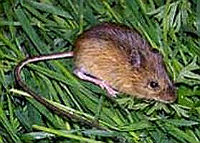Dipodid Hybrids
Family Dipodidae
Mammalian Hybrids
EUGENE M. MCCARTHY, PHD GENETICS, ΦΒΚ
 Pacific Jumping Mouse
Pacific Jumping MouseZapus trinotatus |
Dipodidae sp.
× Mus musculus [Eastern House Mouse] Ackermann (1898) lists this cross, but the cited article (Berichte des Naturwissenschaftlich-medizinischen Vereines in Innsbruck, Jahrgang 1893-1896, vol. 22, p. xvii) does not refer to a hybrid of this type. The following quoted material is the passage to which Ackermann refers: “In der sich anschliessenden Besprechung berichtet Prof. Heider von Erfahrungen, die bei Kreuzung von Spring- und weissen Mäusen sich ergeben und dahin zu deuten seien, dass bei der concurrenz zweier verschiedener neuerer Keimeigenthümlichkeiten die alte nicht abgeänderte Keimanlage den Sieg erlange, und gleichsam in Verlegenheit gebracht, die Natur die alte, ursprüngliche Art zur Geltung gelangen lasse.” Mistakenly citing Ackermann, Gray (1972) lists this cross as Jaculus jaculus × Mus musculus.
Jaculus jaculus[Lesser Egyptian]
× Mus musculus[Eastern House Mouse] See: Dipodidae sp. × Mus musculus.
Zapus hudsonicus[Meadow Jumping Mouse]
× Zapus princeps[Western Jumping Mouse] ENHR(w U.S.). Genetic data indicates hybridization occurs in extreme northern Colorado and southeast Wyoming. Riggs et al. 1997. Internet Citations: WYNDD, WYNDD2, WYNDD3.
Zapus princeps[Western Jumping Mouse]
See also: Zapus hudsonicus.
× Zapus trinotatus [Pacific Jumping Mouse] In both northern Washington and southern Oregon, Himes and Kenagy (2013) found individual jumping mice at the same sampling localities which had mtDNA haplotypes assigned either to princeps or trinotatus. However, no hybrids were specifically reported.
Zapus trinotatus [Pacific Jumping Mouse] See: Zapus princeps
By the same author: Handbook of Avian Hybrids of the World, Oxford University Press (2006).